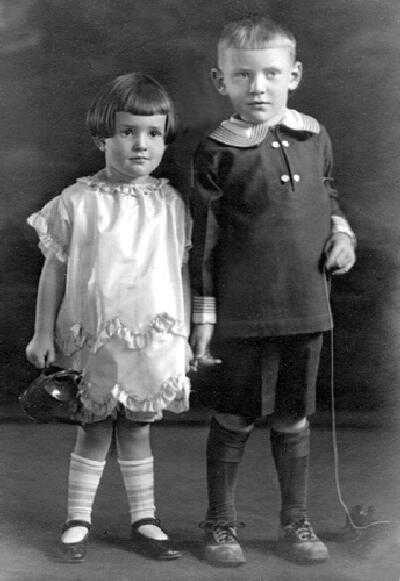
Saddle Shoes: Conventions

Figure 1.--This may be the earliest photo wehave seen of a boy wearing saddle shoes. The child on the left looks like WWI period, or very early 1920s. Unfortunagtely the image is undated. The children re dressed up for the portrait. We are unsure, however, if the boy's shoe are colored saddle shoes or dirty white ones. The reader who sent this image to us tells, All I know for sure about this portrait is that it is Americam, probanly taken in w Wisconsin. The shoes are certainly well worn, but because of the uniformity of pattern, I'd say they are two-tone, and look like saddle shoes. I don't think I have seen shoes before that have this lacing design. Saddle shoes were "invented" in 1906 or 1908 as athletic shoes, so the time period is o.k. As I've said in a previous email,. I saw pictures of children wearing saddle shoes in a Sears 1923 catalog. However, I don't remember if you could buy a pair from the catalog. If you could, this would explain how they got Wisconsin.
|
The conventions for wearing saddle shoes have varied over time. We are not yet sure about the early conventions for wearing saddle shoes. We have the impression that were a kind of sporty shoe for youth. We have also seen, however, boys wearing them in the 1920s. We have not note many images of younger boys wearing them, but the fact that we have noted some means that they were available in sizes for younger children and some boys did wear them. The images we have seen suggest that they were a kind of dressy shoe for informal occassions rather than a play shoe. Teenagers seem to have worn them as a casual shoe, but we have seen some teenagers wearing them withj suits. These conventions changed over time. Beginning in the 1970s, saddle shoes began to be used with dressy outfits for little boys. Thus boys wearing short pants Eton suits and other dressy outfits might also wear saddle shoes.
Casual Wear
The saddle shoe has primarily been worn as a casual shoe style. We are not yet sure about the early conventions for wearing saddle shoes. We have the impression that were a kind of sporty shoe for youth.
Saddle shoes were considered to be a rather sporty shoe and were worn
like loafers in the years before sneakers were fasionable. They were not worn on dressy occasions by boys, but might be worn for informal occasions by older boys with sport jackets. Saddle shoes were interesting in that they were worn by boys of all ages. Often older boys do not want to wear styles worn by younger boys, but saddle shoes appears to have been acceptable to all age groups. We have also seen, however, boys wearing them in the 1920s. We have not note many images of younger boys wearing them, but the fact that we have noted some means that they were available in sizes for younger children and some boys did wear them. The images we have seen suggest that they were a kind of dressy shoe for informal occassions rather than a play shoe. Teenagers seem to have worn them as a casual shoe, but we have seen some teenagers wearing them withj suits.
Beginning in the 1970s, saddle shoes began to be used with dressy outfits for little boys. Thus boys wearing short pants Eton suits and other dressy outfits might also wear saddle shoes. I'm not sure why saddle shoes have made this leep from casual to dressy shoes. Perhaps it was that even little boys, especially in America, stopped wearing strap shoes for formal occasions. Some type of shoe was needed for formal dress. Saddle shoes are even worn as part of a dressy suits for ring bearers and page boys at formal weddings. Certainly the boys probably find saddle shoes preferable to some
of the alternatives such as sandals, buckle shoes, and strap shoes.
HBC

Navigate the Historic Boys' Clothing Web Site:
[Return to Main saddleshoe page]
[Introduction]
[Activities]
[Biographies]
[Chronology]
[Clothing styles]
[Countries]
[Girls]
[Bibliographies]
[Contributions]
[FAQs]
[Glossaries]
[Links]
[Satellite sites]
[Tools]
[Boys' Clothing Home]
Created: 11:03 PM 6/24/2005
Last updated: 11:03 PM 6/24/2005



